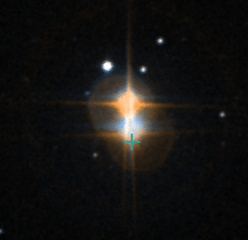Star of the Month
Lalande 21185
AKA: Gliese 411; HD 95735; SAO 62377; BD+36 2147
Position: 11 hrs 03 min 20.2 sec +35 degrees 58 min 12 sec
Due south at 22:28 (BST) on 15 April 2022
Lalande 21185 ( marked with a cross)
The star above it is unconnected and is just an ordinary star
Image: Simbad (http://simbad.u-strasbg.fr/simbad/)
Much of the interest of Lalande 21185 is in its history. It was first catalogued by the French astronomer Jérôme Lalande in 1801, but at the time it was just considered to be an ordinary if rather dim star. Having discovered the high proper motion of Groombridge 1830 in 1842, Friedrich Wilhelm Argelander found Lalande 21185 had a high proper motion as well in 1857. Soon afterwards, another German astronomer Friedrich August Theodor Winnecke measured a large parallax of 0.511 arcseconds, thereby showing that this star was one of the closest stars to our solar system. It is now known to be the fourth closest star, with only the Alpha Centauri system and two other red dwarfs – Wolf 359 and Barnard’s Star (see Star of the Month for June 2020) – being closer. Lalande 21185 is the brightest red dwarf in the sky, but it is still only magnitude 7.5, as red dwarfs are so dim in absolute terms. Like all red dwarfs it is both small and cold, with a mass about 0.4 solar masses and a surface temperature of 3600K compared with the Sun’s 5800K. It considered to be a flare star and an eruptive variable, but it is apparently rather placid for a red dwarf, although it does emit X-rays. It has at least two and possibly three planets, but none of them are within its Goldilocks zone. In any event, the viability of life in the presence of a flare star must be doubtful. Its age is uncertain, but estimated at between 5 and 10 billion years, or a bit older than our Sun. At present, its distance is put at 8.3 light years. In just under 20,000 years it will be 4.65 light years from the Sun; roughly the same distance as Alpha Centauri today, but much dimmer.
Lalande 21185 lies in Ursa Major near the boundary with Leo Minor. To find Lalande 21185, find 46 Leo Minor, magnitude 3.8, and Lalande 21185 lies to its north-east in a rather sparse field, between two dim stars, the variable star CO Ursae Majoris (mag. 5.7) and HD 95129 (mag. 6.0). If you use go-to, which is recommended, you can use its SAO number 62377. Although it is fairly dim, at magnitude 7.5 it should be an easy spot in a telescope or even 10x50 binoculars. Its B-V value of 1.4 suggests that it will be yellow like Arcturus rather than actually red.
